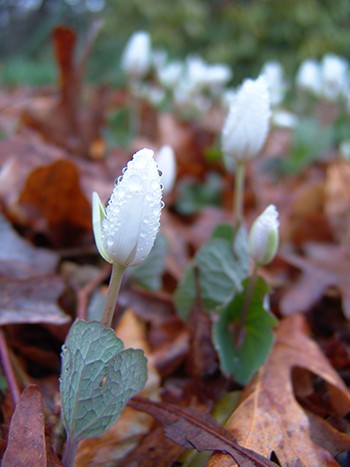Plants of the Week: April 20
Pieris japonica
By far, one of my favorite fragrances in the spring is in April when the delicate, pendulous, clusters of bell-like flowers of Pieris japonica bloom. They have a strong, sweet scent that isn’t overpowering, but similar to hyacinth. The leaves emerge bronze-colored and are evergreen while the bark is interestingly striped and shallowly furrowed. As a member of the family Ericaceae it is related to Rhododendron. Pieris is commonly called the Japanese andromeda as a remnant from a previous taxonomic classification in the genus Andromeda. Though native to Eastern Asia, it has become a common garden plant in this area. photo credit: J. Bickel
Rhododendron ‘Montchanin’
Hybridized by the late horticulturist Guy Nearing, ‘Montchanin’ is a lovely, evergreen, cross of Rhododendron pubescens x Rhododendron keiskei. The blossoms emerge in terminal clusters and are a bright, translucent white with long stamens. Each flower presents a long curved pistil with a bright red tip. This cultivar is not quite a small leaf rhododendron and not quite a large leaf, but somewhere in between. This specimen can be found near the overlook at the Scott Outdoor Amphitheater. photo credit: J. Bickel
Sanguinaria canadensis
The small peculiarities of Sanguinaria make it one of my favorite spring wildflowers. A member of the poppy family, Papaveraceae, it is the only member of its monotypic genus. The flowers come up in early spring emerging singly with a unique, lobular-dissected leaf. When they first break through the soil, the leaves shield the flowers and resemble pallid, bluish fingers poking up from the ground. When they are damaged, the plants release a red-orange sap that resembles animal blood, granting it the common name bloodroot. The flowers are a clean white (rarely streaked with pink) with yellow reproductive structures; bearing 8-10 petals, but also available in the industry in an attractive doubled form cultivar. photo credit: R. Robert





![Pieris japonica JTB [1]](/wp-content/uploads/2015/04/Pieris-japonica-JTB-1-400x300.jpg)
![Rhododendron 'Montchanin' JTB [1]](/wp-content/uploads/2015/04/Rhododendron-Montchanin-JTB-1-400x300.jpg)

No Comments